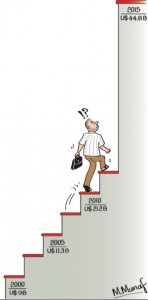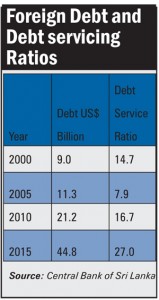Columns
The crippling burden of mounting foreign debt servicing costs
View(s):
The massive increase in the country’s foreign debt and its huge debt servicing costs are a severe burden on the economy. They are a severe strain on the public finances and external reserves of the country.
The current balance of payments crisis is very much due to this. Therefore bringing down the foreign debt is vital for reinforcing the external finances of the country and ensuring economic stability.
Increasing foreign debt
The nation’s foreign debt increased sharply since 2000. The increase was particularly high after the end of the war. The foreign debt that was US$ 9.0 billion in 2000, doubled to US$ 18.6 billion in 2009 and increased to US$ 21.2 billion in 2010. It more than doubled again in the next five years to US$ 44.8 billion in 2015. The increase in foreign debt from US$ 18.6 billion in 2009 to US$ 44.8 billion at the end of 2015 was an increase of 140 per cent.
Current debt burden
The foreign debt grew by a significant amount last year, from US$ 42.9 billion to US$ 44.8 billion. As a proportion of GDP, it increased from 53.6 per cent of GDP in 2014 to 54.4 per cent of GDP in 2015. Consequently, foreign debt servicing costs increased significantly in 2015, absorbing 44.5 percent of the country’s export earnings and 27 percent of the year’s earnings from exports and services. The foreign debt was more than four times the 2015 export earnings of US$ 10.5 billion.
According to the Central Bank Annual Report of 2015, both capital and interest payments increased in 2015. Capital repayments were US$ 3.46 billion in 2015 compared to US$ 2.32 billion in 2014. Interest payments increased to US$ 1.22 billion in 2015 compared to US$ 1.16 billion in 2014. The total debt servicing costs (capital repayments and interest costs) of US$ 4.68 billion was 45 per cent of the country’s export earnings in 2015.
 Gravity of debt
Gravity of debt
Most worrying is the increasing trend in capital and interest payments that is expected in the coming years owing to the increasing foreign debt and higher interest costs. The Central Bank Annual Report for 2015 has warned of the increasing debt servicing costs:
“With the expected gradual increase in global interest rates and financing requirements” the debt service ratio is “expected to increase further” unless the inflow of non-debt creating financial flows, such as FDI and services exports are increased to compensate additional future borrowing requirements”.
Exports inadequate
Inadequate export growth has been an underlying reason for the increasing debt service burden. Whereas repayment of external debt and interest has more than doubled over the last five years, earnings from exports have not grown commensurately. As a result, the ratio of debt servicing to exports of goods and services more than doubled from 13.2 per cent in 2011 to 27.7 per cent in 2015. While debt service payments increased 160 per cent from US$ 1.8 billion in 2011 to US$ 4.7 billion in 2015, exports grew only 24 per cent from US$ 13.6 billion in 2011 to US$ 16.9 billion in 2015.
Fortunately workers’ remittances and earnings from tourism of nearly US$ 10 billion more than offset the entire trade deficit of US$ 8.4 billion in 2015. Remittances and tourist earnings were only slightly less than the total earnings from the export of goods (merchandise) of US$ 10.5 billion.
Economics of foreign borrowing
Foreign borrowing is not intrinsically bad. It can assist in resolving constraints in foreign resources for development. It could be an important means of spurring an economy to a higher trajectory of economic growth than its resources permit. However, it is important that foreign debt be incurred for developmental purposes.
 Although it has been argued that 75 per cent of recent foreign borrowing has been for infrastructure development such as for power and energy, ports, roads, bridges, water supply, agriculture, fisheries and irrigation, most of these would have a long gestation period. The massive amounts of borrowing at high interest costs and long gestation periods heaped a huge burden on the country’s finances, especially external finances.
Although it has been argued that 75 per cent of recent foreign borrowing has been for infrastructure development such as for power and energy, ports, roads, bridges, water supply, agriculture, fisheries and irrigation, most of these would have a long gestation period. The massive amounts of borrowing at high interest costs and long gestation periods heaped a huge burden on the country’s finances, especially external finances.
All infrastructure development is not necessarily justified from an economic perspective. Many infrastructure projects are not only hugely expensive, they also have a long gestation period. The benefits of some infrastructure investments in relation to their costs are doubtful. Some have been dubbed White Elephants. Infrastructure projects that either save foreign exchange or earn foreign exchange are the least burdensome on the foreign finances of the country. Prioritisation of infrastructure development on the criterion of their contribution to the country’s balance of payments is a prudent strategy for investment from foreign borrowing.
Resolving the problem
The large foreign debt and its servicing cost is a serious constraint to long term economic development and have serious implications for macroeconomic policy, economic growth and development. Ways and means must be found to reduce the foreign debt to manageable proportions.
The foreign debt can be brought down by generating a balance of payments surplus and prudence in further borrowing. Bringing down the trade deficit to below US$ 7 billion is needed to generate such a surplus through earnings from tourism and other services and workers’ remittances. Curtailing unnecessary imports is important to narrow the annual trade deficit, while export growth is vital. Monetary and fiscal policies should be mindful of their balance of payments implications.
Foreign direct investment (FDI) has been sluggish and inadequate. FDI was only US$ 0.7 billion last year. Increased FDI, especially in export industries, is important to expand exports. A political and business environment that is conducive to FDI would be most helpful in increasing exports.
With the IMF loan facility of US$ 1.5 billion, other expected foreign funds and better prospects for exports this year with the lifting of the EU ban on fish exports and restoration of the GSP Plus concession and increased tourism, it should be possible to achieve a balance of payments surplus of over US$ 2 billion that would improve the country’s external finances. This improvement must be used to reduce the foreign debt burden.


Leave a Reply
Post Comment